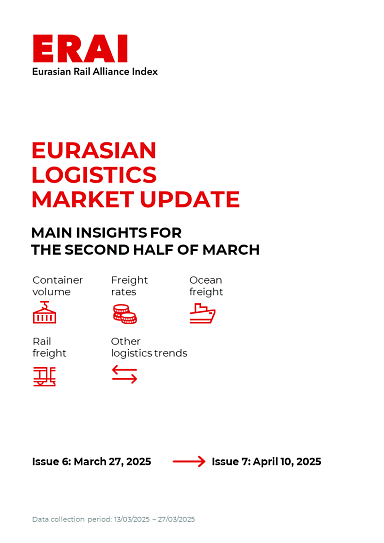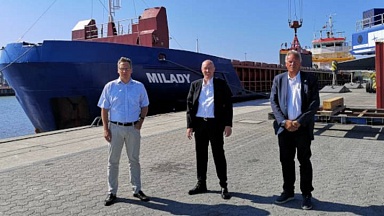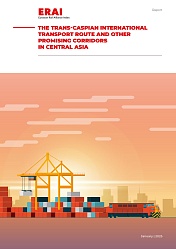China-Europe logistics market
Demand outlook
-
In March 2025, the eurozone manufacturing sector showed moderate recovery, with the PMI rising to 48,7, the highest level since January 2023 [S&P Global]. However, the trend in business activity remains uncertain due to continued weak demand for European products, including from Asia. Companies remain cautious in purchasing and continue to reduce inventories. Nonetheless, S&P Global notes early signs of a potential turnaround.
-
China’s economy is stabilizing, driven by domestic consumption stimulus and growing exports, which are expected to support freight volumes to Europe. However, rail freight is facing growing competition from the expanding Ro-Ro fleet, with Chinese automakers such as BYD, Chery, and SAIC actively investing in logistics aiming to take control of their export logistics [SCMP]. Despite deflation risks and trade barriers, economic forecasts for China are improving [Reuters].
-
According to WorldACD, air cargo demand from Asia to Europe has grown at a steady pace over the past five weeks, increasing by an average of 5% per week. Volumes are now approaching mid-December levels, which may indicate a recovery in external demand for Asian goods, particularly in time-sensitive segments (electronics; auto components; clothing, footwear, and accessories).
-
China-Europe rail container traffic declined sharply in February, falling 29% YoY and 4% MoM. The increase in alternative corridor volumes was driven by delayed shipments from 2024, held up by adverse weather conditions. The port of Aktau continues to face disruptions — as of March 23, the berths have been closed indefinitely due to weather. Transshipment times at Aktau remain between 15–30 days, with delays also reported in Baku.
-
In the ocean freight market, demand is gradually recovering, but excess capacity persists [Flexport]. Despite recent blank sailings due to congestion in European ports, available capacity remains more than sufficient.
Freight rate trends
-
The average rail freight rate on the China—Europe route (SOC) fell by approximately 3% MoM. Rates currently range between $5 250 (Chengdu) and $6 100/FEU (Shenzhen). Container leasing rates have remained stable.
-
Intensifying competition for cargo from Asia is reflected in the latest index readings. WCI Shanghai—Rotterdam continued its steady decline last week, reaching $2 370/FEU (-8% MoM, -25% YoY) [Drewry]. In the short term, conditions are not favorable for sustained rate increases, prompting carriers to once again delay GRI implementations. While some short-term GRIs may take effect, the broader outlook points to heightened competition among carriers and a continued downward trend in rates. J.P. Morgan analysts forecast a 30% YoY drop in freight rates in 2025 [JOC]. The futures curve points to a gradual rate increase, reaching ~$2 900/FEU by late summer.
Other trends
- Vietnam has approved a $8.4 billion project to construct a standard-gauge railway from the port of Haiphong to the Chinese border (Lao Cai), enabling direct integration into China’s rail network [Caixin Global]. Another project, the Thailand—China rail (via Laos) will connect Bangkok to Kunming. Despite delays, it remains a strategic priority, offering ASEAN countries a land connection to China and further into Europe.
China-EAEU logistics market
Import and export trends
-
On March 21, 2025, the Bank of Russia decided to keep the key rate at 21% per annum, inflationary pressure remains high despite some recent drop. According to the forecast of the Bank of Russia, given the ongoing monetary policy, annual inflation will decline to 7,0-8,0% in 2025, will return to 4,0% in 2026 and will be on target thereafter. It is noted that the emerging trends in the dynamics of economic activity create prerequisites for a smooth return of the economy to balanced growth.
-
The index of the population’s propensity to make large purchases in the first quarter of 2025 fell by 3 p.p. to negative 22%, while the favorability of conditions for savings fell by 1 p.p. to 22%, continuing to decline from its peak at the end of 2024 [Kommersant].
-
The ruble continues to strengthen its positions. As of March 25, the official rate against the U.S. dollar is 83,87 rubles [Bank of Russia]. Amid the ruble’s recent strengthening, players in the car sales market report that lower consumer demand and efforts by sellers to clear out older inventory have already led to some price reductions. If the ruble continues to gain value, prices may come under further downward pressure—especially with the anticipated hike in the vehicle scrappage fee, which will primarily affect imported cars [IZ]. The early sale of vehicles from storage is also expected to drive demand for new deliveries. According to Kommersant, sales of new passenger cars in Russia are projected to exceed 80 thousand units in March 2025, up 2,6% MoM.
-
Ongoing geopolitical shifts, which began in February, have prompted households to spend more cautiously—many anticipating the return of foreign brands to the Russian market. Meanwhile, the ruble continues to strengthen, which could weigh on exports. Although the stronger currency would typically support import volumes, they are likely to remain subdued in the short term due to other factors, including relatively weaker demand, a high key interest rate, and persistent challenges concerning international transactions.
-
Freight rates for imports from China to Moscow have started to level off after a rapid decline earlier. The cost of transportation by direct train is ~$5 000/FEU, which is ~$200 lower than two weeks ago. Rates for shipments via Far East Russian ports decreased by ~$150 to ~$5 000/FEU, while the rail component decreased by ~$50 to ~$4 000.
Other trends
- According to LogiStan, KTZ plans to begin freight train operations on the second track of the Dostyk—Beskol section (part of the Dostyk—Moyinty railway line) by the end of March 2025. The full construction of the second track along the 836-kilometer Dostyk—Moyinty line is scheduled for completion between June and July 2025. Once finished, the route’s throughput capacity is expected to increase fivefold.





